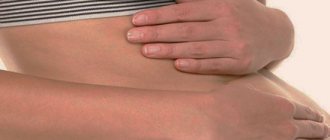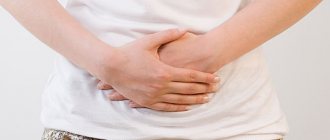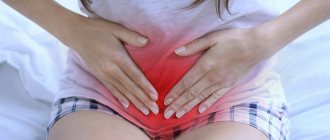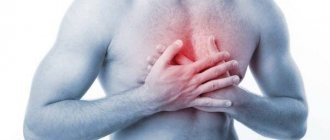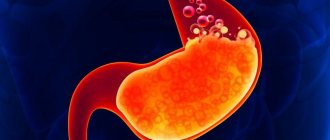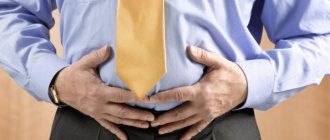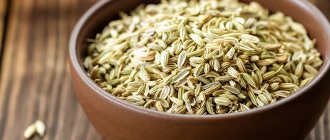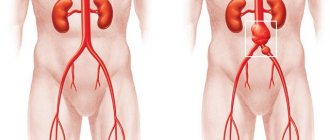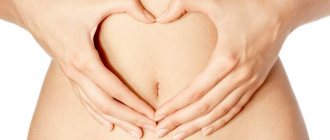Causes of pain in the upper abdomen
There are many factors that provoke pain. Symptoms may also indicate a foreign body in the human body or the development of a particular pathology.
Abdominal injuries
Even if there are no visible signs of injury (for example, hematoma), with blunt injuries, alarming symptoms may appear.
For example, such a condition could be a consequence of:
- Rib fracture.
- Splenic rupture. Most often, this type of injury results from a blow to the left hypochondrium. The pain is usually accompanied by very heavy bleeding, which can cause loss of consciousness.
- Liver rupture. The main consequence of such an injury is hemorrhage directly in the liver itself. When a cavity filled with blood forms, severe pain occurs.
Stomach ulcer
This is one of the most common causes of pain. The pathology is characterized by an increased level of acidity in the stomach. There are several stages in the development of gastric ulcer. As a rule, at the initial stage the patient is diagnosed with gastritis, which later turns into an ulcer.
Peptic ulcer is the most common gastrointestinal disease
An ulcer usually appears in a person against the background of:
- Poor nutrition. The provoking factor is the constant consumption of very hot, overcooked and spicy foods.
- Autoimmune mechanisms. The immune system begins to produce antibodies against the human body's own cells.
- Lack of vitamins. If a vitamin deficiency is diagnosed, this can cause gastritis.
- Alcoholism. When drinking alcohol in large quantities, the mucous membrane is damaged.
- Smoking. Negatively affects the functioning of the nervous system. Gastric juice begins to be produced too actively.
- Stress. With constant nervous tension, the body begins to actively synthesize special hormones. As a result, a failure occurs in metabolic processes. Damage to the mucous membranes occurs.
Pyloric stenosis
Spasms of this type often become a form of ulcer complication. As this pathology develops, the muscle located at the junction of the stomach and intestines begins to contract too much. Because of this, a narrowing of the lumen occurs. This leads to the fact that the bolus of food cannot pass normally through the stomach and move further through the intestines.
The problem may lie in the muscle itself, which constantly experiences spasms or against the background of the development of pyloric stenosis.
Symptoms for this diagnosis have the following features:
- pain becomes more intense and obvious after eating (not immediately, but after 1-2 hours);
- the pain is much more noticeable if a person eats solid foods or overeats;
- the pain is not constant, but periodic, of medium intensity;
- after lunch, an attack of vomiting often occurs;
- frequent belching and an unpleasant burning sensation reminiscent of heartburn appear.
Cholecystitis
As a rule, this disease is diagnosed when stones appear in this organ.
With cholecystitis, the pain syndrome is paroxysmal in nature. This symptomatology is called biliary colic. Pain may vary in intensity depending on the stage of the diagnosed pathology. Unpleasant pain is localized under the ribs on the right side.
Pancreatitis
“The upper abdomen hurts” - with this description of the symptoms, patients come to the doctor also for this disease. The condition may be sluggish. It occurs due to alcoholism or the formation of stones.
If a patient is diagnosed with acute pancreatitis, then the pain is predominantly localized around the navel. Also, discomfort may appear under the ribs closer to the back. With a sharp exacerbation of the pathology, hospitalization is required.
Pancreatitis can also occur in a chronic form. Then there are practically no alarming pain symptoms observed. From time to time the patient may complain of minor pain, but no serious attacks occur.
The most discomfort is felt when eating. As a rule, such symptoms disappear after the patient goes on a special diet and eats exclusively the foods recommended by the doctor.
Oncological diseases
It all depends on which organ the tumor begins to develop in. Based on this, oncological diseases are divided into several categories.
| Organ affected by cancer | Features of symptoms |
| Esophagus | The pain radiates more to the chest area. Even before the onset of pain, patients' swallowing function is impaired. |
| Stomach | A dull pain that becomes more intense as tissue is destroyed. Additionally, there may be problems with bowel movements. |
| Liver | As a rule, liver cancer develops as a complication of progressive cirrhosis. Patients also experience symptoms of jaundice, fever, and ascites (when too much fluid accumulates in the abdomen). |
| Gallbladder | It is a complication after cholelithiasis. Shortly after the first abdominal pain appears, you should pay attention to problems with stool and the appearance of signs of jaundice. |
| Pancreas | The pain is felt most in the area of the lower ribs. In this case, the unpleasant sensations disappear if the patient takes the fetal position. |
Spleen diseases
With the development of pathologies affecting this organ, pain is most strongly felt by the patient in the area under the ribs on the left side. The pain is acute, but quite rare. More often, patients complain not of pain, but of discomfort. This is due to an increase in the size of the internal organ.
If the patient experiences noticeable pain, then in this case there is a separate list of diseases affecting the spleen.
| Disease | Features of manifestation |
| Splenomegaly | The pain is localized under the ribs on the left side. The discomfort increases noticeably even with minor movements. |
| Diseases of hematological type | The enlargement of the spleen is caused by changes in blood composition. |
| Splenic rupture | Attacks of acute pain. They start suddenly. |
| Splenic infarction | Characterized by a sudden cessation of blood supply to the spleen. The tissues of the organ begin to quickly die, causing severe acute pain. |
| Spleen abscess | A large amount of pus accumulates around the organ. This also causes severe pain during finger examination (palpation). |
Liver diseases
If a person suffers from heart failure, infectious diseases, or chemical reagents enter the body that cause swelling of the liver, then intense and prolonged nagging pain may appear. It is noteworthy that the pain seems to come from within. At the same time, patients complain of a constant feeling of discomfort.
Stones may form in the liver. The organ may begin to malfunction or suffer from infection. All this also provokes pain. Additionally, patients constantly complain of increased sweating, vomiting and nausea.
Spinal diseases
If you have pain in the upper abdomen, you need to take into account that the organs of this cavity are very close to the spinal cord. Therefore, any diseases affecting the spine can also manifest themselves in a similar way. But pain due to spinal pathologies is rarely intense. As a rule, these are long-lasting, dull pains. Relief occurs when the posture changes.
Arachnoiditis of the thoracic spine causes pain in the upper abdomen
Similar symptoms are often found with osteochondrosis, minor and more serious back injuries, spinal tumors and arachnoiditis.
Myocardial infarction
We are talking about the death of a separate segment of the heart muscle. Typically, in this case, patients experience severe pain in the chest area. However, with an infarction of the posterior wall, which is in contact with the diaphragm, so-called atypical pain may appear. In this case, the discomfort is localized a little lower, in the upper abdomen.
Additional symptoms include vomiting, but there are no other manifestations of gastrointestinal problems. Additionally, patients pay attention to the appearance of severe shortness of breath, increased sweating, and increased heart rate.
Other possible diseases
“Upper abdomen hurts” is a fairly general description of the symptoms. A similar syndrome can occur in a variety of conditions.
| Disease | Features of manifestation |
| Hepatitis | Relatively tolerable pain, which is more like a feeling of discomfort under the ribs on the right side. At the moment of turning the body, the pain becomes acute. Symptoms also increase with exercise. |
| Peritonitis | Intense and prolonged pain syndrome, accompanied by constant tension of the abdominal muscles. Patients also complain of constant nausea and problems with bowel movements. |
| Porphyria | Pain in the form of sudden attacks. They are also localized in the upper part of the peritoneum. |
A person can encounter such pathologies or conditions at any age.
Gallstones
Like pancreatitis, gallstone disease becomes suspiciously younger. If earlier you thought about problems with stones after 60, now it’s time to pay attention to your gallbladder already at 30–35 years old.
Regular discomfort in the epigastric area may indicate that there are problems with the outflow of bile. The thicker the bile, the greater the possibility of stone formation. And this is logical: first, bile forms clots, which then have a chance to transform into stones. At the stage of clots, this problem can be solved with the help of drugs - they dilute the bile, and the clots disappear.
But in order not to lead to surgery, at the first symptoms - discomfort and pain in the epigastrium - you need to undergo an ultrasound. So that the doctor can properly examine your gallbladder, you need to prepare for the ultrasound: come on an empty stomach and do not eat gas-forming foods 3 days before the examination.
Pain in the upper abdominal area should not be taken as normal. This is a dangerous symptom that indicates serious pathologies, many of which can become fatal if medical help is not sought promptly. Frequent pain under the ribs, approximately in the center, must be diagnosed by determining the exact causes and nature of the pain.
It is important to remember that not every pathology allows you to wait for an opportunity to see a doctor. Many diseases characterized by pain in the center of the torso require immediate hospitalization.
That is why, at the first sign of pain under the ribs in the solar plexus area, it is necessary to urgently seek medical help.
Features of pain syndrome in men and women
In male patients, abdominal pain may indicate incipient inflammation of the prostate. The doctor must also exclude the possibility of developing urethritis, ascending infection, or sexual dysfunction.
As a rule, men face similar problems against the background of rare or too vigorous sex life, constant sitting and constant constipation. Alcohol doesn't have the best effect.
In female patients, pain may be the primary sign of inflammation of the reproductive system. In this case, not only pain may appear, but also periodic sensations of discomfort in the iliac region. Additionally, signs of intoxication may appear (chills, loss of appetite, weakness and dizziness).
In a child, pain syndrome may also appear against the background of hepatitis, gastritis, poisoning, enlarged spleen and many other pathologies. Therefore, you should immediately contact a gastroenterologist.
Diagnostics
Even an experienced gastroenterologist will not be able to immediately make a diagnosis. Therefore, a comprehensive examination will be required. First of all, the doctor interviews the patient and clarifies the nature and location of the pain. You need to remember when the pain syndrome began, in what situations it intensifies, and under what conditions the pain goes away.
After this, a primary examination is carried out, which includes:
- Palpation. The doctor evaluates the condition of the abdomen and checks whether the pain increases when pressing on the abdomen.
- Visual inspection. A gastroenterologist will be able to determine whether the patient is suffering from increased gas, an allergic reaction, or swelling.
- Auscultation. Thanks to this procedure, it is possible to hear various sounds in the organs. A stethoscope is used for the examination.
- Percussion. The procedure is necessary to determine the density of tissue in the upper abdominal cavity.
After an initial examination and examination, the doctor can suggest a possible pathology, but most often the gastroenterologist gives the patient a referral for radiography. This procedure is aimed at “enlightening” body tissues using micro-rays from an X-ray machine.
Thanks to this study, it is possible to determine the presence or absence of:
- malignant tumors;
- formed stones;
- spine pathologies;
- ulcers;
- abscesses in the liver or the abdominal cavity itself;
- hernias
After studying the research results, the doctor decides whether to refer the patient for additional examinations.
If there is such a need, then in addition the gastroenterologist can give a referral to:
- computed tomography;
- magnetic resonance imaging;
- ultrasound examination;
- fibroesophagogastroduodenoscopy (endoscopic examination of the esophagus and stomach);
- microbiological studies (eg microscopy);
- cultural examination;
- study for the presence of antigens and antibodies in the body;
- clinical and biochemical analysis of blood and urine.
These studies are very expensive, so first of all you should go to the clinic at your place of registration. If you undergo examinations in private medical centers, then you need to prepare for the fact that the CT scan of the spine alone will cost about 6,000 rubles, and testing for the presence of antibodies will cost at least 5,000 rubles.
When to see a doctor
Many people sometimes have stomach pain. As a rule, after some time the symptoms go away. However, there are a number of situations that require immediate diagnosis and, in some cases, hospitalization.
You should urgently contact a gastroenterologist if:
- constantly increasing pain in the abdominal area;
- in the absence of any positive effect from taking medications (for example, if a person has bloating and the medications do not have any effect);
- obvious signs of intoxication (the appearance of severe vomiting or diarrhea);
- severe and even cutting pain with every urination;
- the appearance of bloody inclusions in urine or feces;
- the appearance of pain during a change in body position;
- receiving a severe abdominal injury, falling or being injured;
- acute pain at night;
- pain that is accompanied by a fever;
- the appearance of pain from touching the stomach.
Pain in the upper abdomen is a typical description of a symptom of many pathologies. Therefore, you should not treat yourself, as the situation can only get worse.
Diseases that cause pain under the ribs
Pain under the ribs is an extremely common symptom. The most common diseases that cause pain under the ribs are:
- diseases of the gastrointestinal tract: diseases of the duodenum and stomach (ulcer), liver, gall bladder, pancreas.
- enlarged spleen
- liver and spleen injuries
- retroperitoneal hematoma
- subphrenic abscess
- gastralgic form of myocardial infarction
- diseases of the urinary system
- lung diseases
- disorders of neuroendocrine regulation
- osteocondritis of the spine
In diagnosis, the symptoms that accompany the pain, in particular vomiting, nausea, fever, as well as the history of pain, including trauma, hypothermia, and dietary errors, are of great help. A thorough analysis of these factors, taking into account diseases that were previously diagnosed, makes it possible to fairly accurately make a preliminary diagnosis and determine which specialist to contact to prescribe treatment.
Treatment methods
To get rid of unpleasant symptoms, you first need to cure the disease that provokes the pain syndrome. In this case, medications prescribed by a doctor can be used, and alternative treatment methods can be used as additional treatment.
Medications
A gastroenterologist prescribes medications that help alleviate or cure the pathology that causes pain. Therefore, everything depends on the specific diagnosis.
For example, for peptic ulcers there are more than three treatment regimens and about 10-15 drugs with different effects:
- Omeprazole. The drug is prescribed for high acidity of the stomach. The drug reduces the production of hydrochloric acid. The product costs about 20-30 rubles. Sold in capsule form. You need to take the drug 20 mg twice a day. The course of treatment is prescribed by a doctor.
- Amoxicillin. This is an antibacterial drug that is prescribed if the patient is suffering from an infection called Helicobacter pylori. The drug costs about 40 rubles. You need to take it 1000 mg 2 times a day.
- Pylorid. Also used to reduce the production of gastric juice. Only in this case, the decrease in acidity is carried out due to pepsin. You need to take 400 mg twice a day. The drug costs 40-50 rubles.
For biliary colic, the doctor may prescribe Aeron. It is taken one tablet per day. In case of exacerbation, you need to take 2 tablets, and after 6 hours another one.
If the patient suffers from acute pancreatitis, then the doctor may prescribe Pancreatin. It also costs about 20 rubles. It is recommended to take the drug 0.5 g before meals.
Traditional methods
In this case, everything also depends on the specific diagnosis:
- For gastritis, motherwort juice has an effective effect. You need to collect young shoots and squeeze the liquid out of them. The resulting medicine should be drunk 1 tsp. shortly before meals. The course of treatment is 1 month.
- For stomach ulcers, you can make potato broth. To do this, you need to thoroughly peel and boil the potatoes without adding salt. The resulting potato water should be drunk before meals 3 times a day.
- For cholelithiasis, rowan infusion is effective. To prepare it, you need to pour 1 liter of boiling water over 50 g of berries and leave the mixture for 4 hours. When it is ready, you need to drink a glass of the liquid 3 times a day.
Other methods
For peptic ulcers and problems with the digestive system, the doctor may prescribe a diet. It is selected individually for each patient.
“The upper abdomen hurts with pancreatitis” is the most common complaint. In addition to taking medications, the patient must observe bed rest and rest. Otherwise, it will only make the pain worse.
If you have food poisoning, you need to drink more water.
Questions and answers on: pain when pressing on the stomach
ALKALINE PHOSPHOTASE 108.6 ALAT 21.9 ASAT 220. BILORUBIN 25.7 . DIRECT 9.17. NOT DIRECT 16.53 PDW platelet, anisocytosis, 18.3% leukocytes 11.2 lymphocytes general 3.52 ULTRASOUND OBESITY LIVER STONES NOT DETECTED BALL DUCTS UNENLARGED, CT ENLARGEMENT OF MESENTERY 9 mm STOMACH - NORMAL ACIDITY MICROBES NO GASTRITIS PROCTOLOGIST - NO POTALOGY I'm worried about heaviness in the LEFT AND RIGHT COASTAL REGIONS, SOMETIMES WHEN PRESSING I EXPERIENCE PAIN IN THE RIGHT SIDE IN THE AREA OF THE PANCREATURAL GLAND, THERE WAS A REFLECTION OF STOMACH JUICE INTO THE LARYNX, THE THROAT WAS TERRIBLY SWELLING, I TOOK CONTROL for 3 WEEKS IT BECAME EASIER BUT NOW b THROAT IS DRY AND I CHOKE OUT GREEN MUcus IN THE MORNING HEARTBURN NO HURT THROAT MORE TREATMENT NO THEY WERE OFFERED TO TAKE A CONTROL AND THERE IS NO DOCTOR IN THE TOWN COMING FROM THE CENTER RARELY HELP WHAT MEDICINES CAN BE TAKEN AND THAT THE DIAGNOSIS HAS NOT BEEN MADE I ASK FOR YOUR HELP AGAIN.
Possible complications
If the patient does not seek treatment when pain occurs due to a peptic ulcer, this can lead to so-called perforation. This means that holes can form in the stomach. As a result, air may begin to enter the abdominal cavity. This is a very dangerous condition.
In addition, the ulcer may cause bleeding. This condition is dangerous because there are no changes in pain symptoms as such. Also, without treatment, an ulcer can develop into a stomach tumor.
If there is no treatment for gallstone disease, there is a risk of blockage of the bile duct and inflammation. An extremely dangerous condition is called peritonitis. In this case, there is a risk of rupture of the gallbladder wall and passage of bile directly into the abdominal cavity. If surgery is not performed immediately, the patient may die.
Pain in the upper abdomen can be a manifestation of a temporary illness (for example, overeating), or it can also be a symptom of a very dangerous condition. If you experience prolonged discomfort, you should visit a doctor and undergo an examination.
